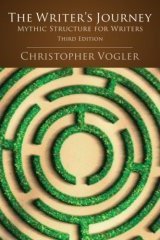We have to be braver than we think we can be, because God is constantly calling us to be more than we are. — Madeleine L’Engle
Frequently we use the word hero interchangeably with main character, and that is what will happen here today. For an excellent excellent discussion of What makes a Hero, click that link.
Even though I say I’m using Hero “just” as MC, I think we should all understand the the reason there’s a story about these people is that they are heroic: proactive, admirable and/or memorable.
~ ~ ~
At it’s worst, “The Hero’s Journey” is an OCD checklist that results in a story as bloated as a cat fed “exactly what the bag says she needs” that has to waddle from place to place.
At it’s best The Hero’s Journey is a psychological map that you can look at next to your story and decide if the terrain is relevant enough for the map to be useful.
Laid out by mythologist Joseph Campbell in his 1949 book, The Hero With a Thousand Faces (which is quite the slog to read, I’ve heard, totally giving you bragging rights if you get through the whole thing), the hero’s journey is often described as a circle, punctuated by tasks or gateways or individuals that shape the story and the aforementioned hero.
 For anyone who wants to explore this venerable (and useful, despite my tone 😉 ) structure, the better work to read would be Christopher Vogler’s The Writer’s Journey. This I have read and can heartily recomend as a reference work. It lays out the whole concept and shows how it can apply to the writers life as well as the storyline s/he is working on.
For anyone who wants to explore this venerable (and useful, despite my tone 😉 ) structure, the better work to read would be Christopher Vogler’s The Writer’s Journey. This I have read and can heartily recomend as a reference work. It lays out the whole concept and shows how it can apply to the writers life as well as the storyline s/he is working on.
The cycle is as follows, but remember, it is shaped as a circle, not a line like this.
One of the philosophical differences I take to this structure is that the stories I enjoy most are about progression and trajectory. The core idea I see here is that you belong where you were, just as a different person. That you can only become through tragedy.
Maybe that’s true, but I’m not going to play that way today.
Step 0. The ordinary world. The “before” pic for your before-and-after shoot.
- Call to Adventure
- Refusal of the call
- ultimate acceptance of the call (or the story wouldn’t move on).
- Helpers appear
- provide training, trajectory, motivation or simply new thoughts that prepare him to overcome
- Resistance (aka Threshold Guardians) shows up.
- This feels like the biggest fight of the young hero’s life– and maybe, but really it’s just the fight to let him enter the arena.
- Cross the threshold (about 25% into your story).
- This is when the story premise really begins: Dorothy is in Oz, Frodo is on the move. This is the action we picked up this story for.
- Tests, Allies and Enemies
- Our hero meets a bit of everything and has to learn to sort through them
- With his band of true friends the hero approaches the Midpoint of the story and his Great-Good Goal
- The Ordeal (Midpoint climax and half-way point of your story)
- also called Belly of the Whale– facing death and/or one’s deepest fears
- The Reward — The hero collects what he came for, but it (and he) is not completely secure yet.
- This can be a physical object, a relationship, an epiphany, now available because he survived the ordeal.
- The Road Back (seems to me that most of The Odyssey is this step. In any case it’s a vivid example of how the road back isn’t a cakewalk.) 75% mark comes somewhere in here.
Resurrection
- This is the climax-climax. The hero faces death/his greatest fears again, but this time, because of the journey, he is different. The moment of victory is the Hero and the rest of the world realizing that he is made new, transformed by his experiences.
- Returning with the Elixar — The hero finishes his journey home, with some tangible element of his journey that will benefit his world has he has benefited.
For a beautiful list with all sorts of clickable trails to get lost in for hours of NT (you know who you are) entertainment, please please click here to visit the Hero’s Journey Page on TVtropes.org.
And if you’ve never heard of or never visited TVTropes before, be prepared to lose yourself down the rabbit hole. For a story-centric person (like myself) it is one of the most delightful ways to lose time on the internet. The bonus (if you’re a writer) is that none of your time will be wasted. It is all research.
You’re welcome.
Terrific links to see actual diagrams and examples are TV Tropes, like I already mentioned, and here, where the author of The Writer’s Journey lays out his interpretation and some application.




3 thoughts on “Plot Structures: The Hero’s Journey (NaNo Prep 13)”